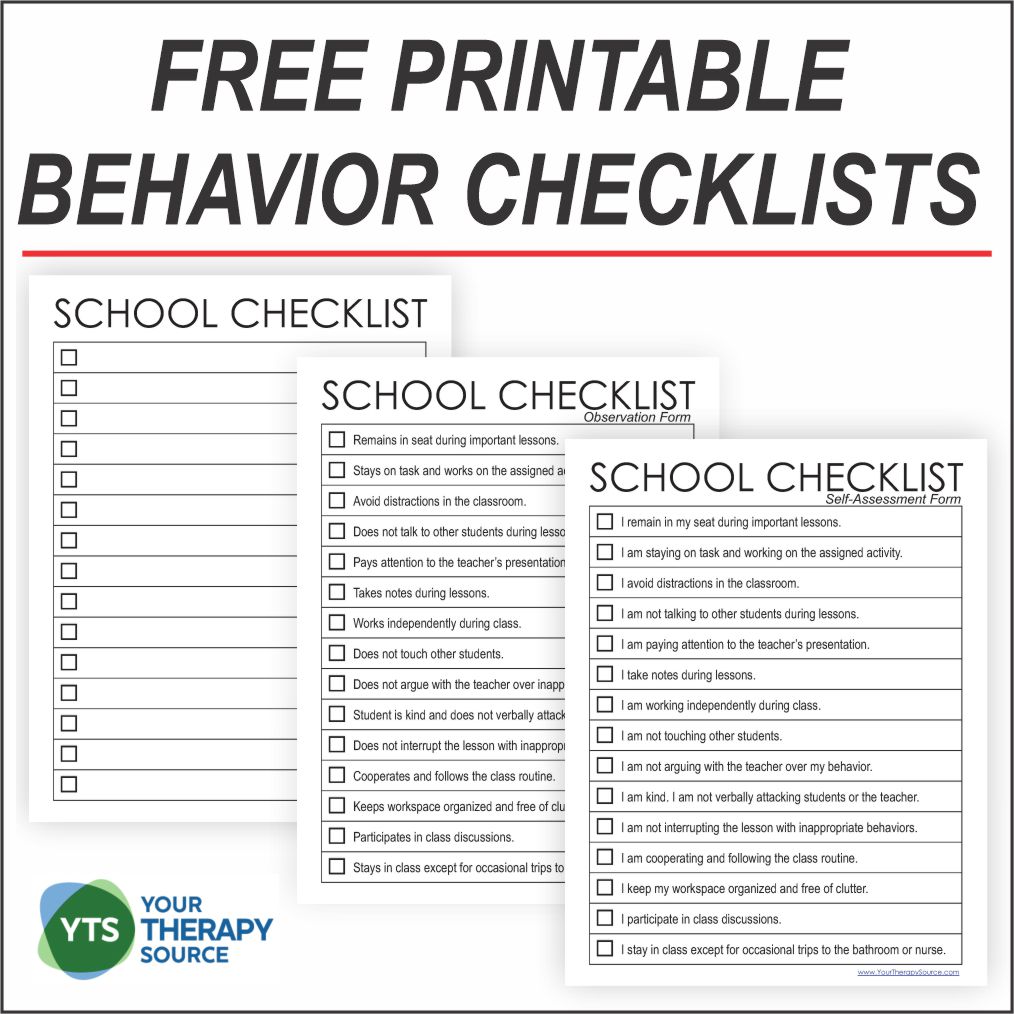Behavior Checklist for Students
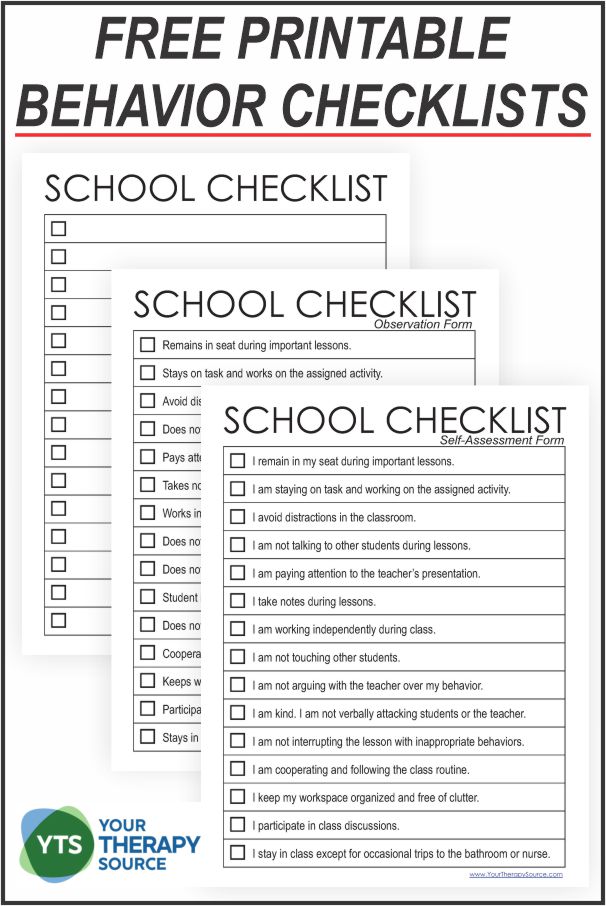
It can be challenging for students to stay focused and engaged all the time. For some students, a behavior checklist can serve as a helpful tool to promote self-awareness and provide gentle reminders for developing key skills. This self-assessment checklist includes common areas where students may need extra support, or you can customize it to fit individual needs. However, it’s important to recognize that factors like developmental readiness, executive functioning challenges, or the need for additional support can impact a student’s ability to meet expectations. Checklists should be used as a flexible and supportive tool, adapted to meet individual needs and encourage growth. You can download your FREE Student Behavior Checklist PDF digital copy at the bottom of the post.
WHAT ARE BEHAVIOR CHECKLISTS?
Behavior checklists are a tool used by teachers to help identify patterns in student behavior and areas where additional support may be needed. A behavior checklist for students can assist both teachers and students in tracking progress and recognizing skills that may require further development. These checklists often include items such as “participates in class,” “remains on task,” and “takes notes.”
While behavior checklists are not a perfect tool, they can be useful in noticing trends and supporting student growth. When used as a self-checking resource, they can help students develop independence and awareness of their actions at school.
Both general education and special education students can benefit from using these checklists when implemented in a supportive and individualized manner.
WHY ARE BEHAVIOR CHECKLISTS IMPORTANT?
Behavior checklists can be a valuable tool in the classroom for some students when used in a supportive and student-centered way. They help teachers recognize areas where students may benefit from additional guidance, ensuring that every child receives the support they need to succeed.
Additionally, behavior checklists can contribute to a positive and structured learning environment by highlighting strengths and areas for growth. Rather than focusing on “correcting” behaviors, these checklists can be used to encourage skill development and foster self-awareness in students.
Teachers can also use checklists as a way to gather meaningful insights over time. By tracking patterns, they can better understand student needs and implement strategies that promote success. When used as a self-assessment tool, checklists can empower students to take ownership of their learning and develop independence in key areas.
For example, if a teacher wants to support on-task behavior, they can use a checklist to observe engagement patterns while also encouraging students to reflect on their own focus and participation. This allows for a more collaborative and strengths-based approach, helping students build confidence and responsibility in their learning.
WHAT ARE EXAMPLES OF CHALLENGING BEHAVIORS IN SCHOOL?
What Are Examples of Challenging Behaviors in School?
There are a variety of behaviors that can impact a student’s success in school. When certain behaviors occur frequently, they may indicate that a student needs additional support to develop skills that help them thrive in the classroom. Recognizing these patterns allows educators to provide appropriate guidance, accommodations, and strategies to foster a positive learning experience.
Some basic categories are:
- decreased attention span
- highly distractable
- hyperactive
- withdrawn
- physically aggressive
- verbally aggressive
- poor anger management
- disruptive
- uncooperative
- poor social skills
- avoids schoolwork
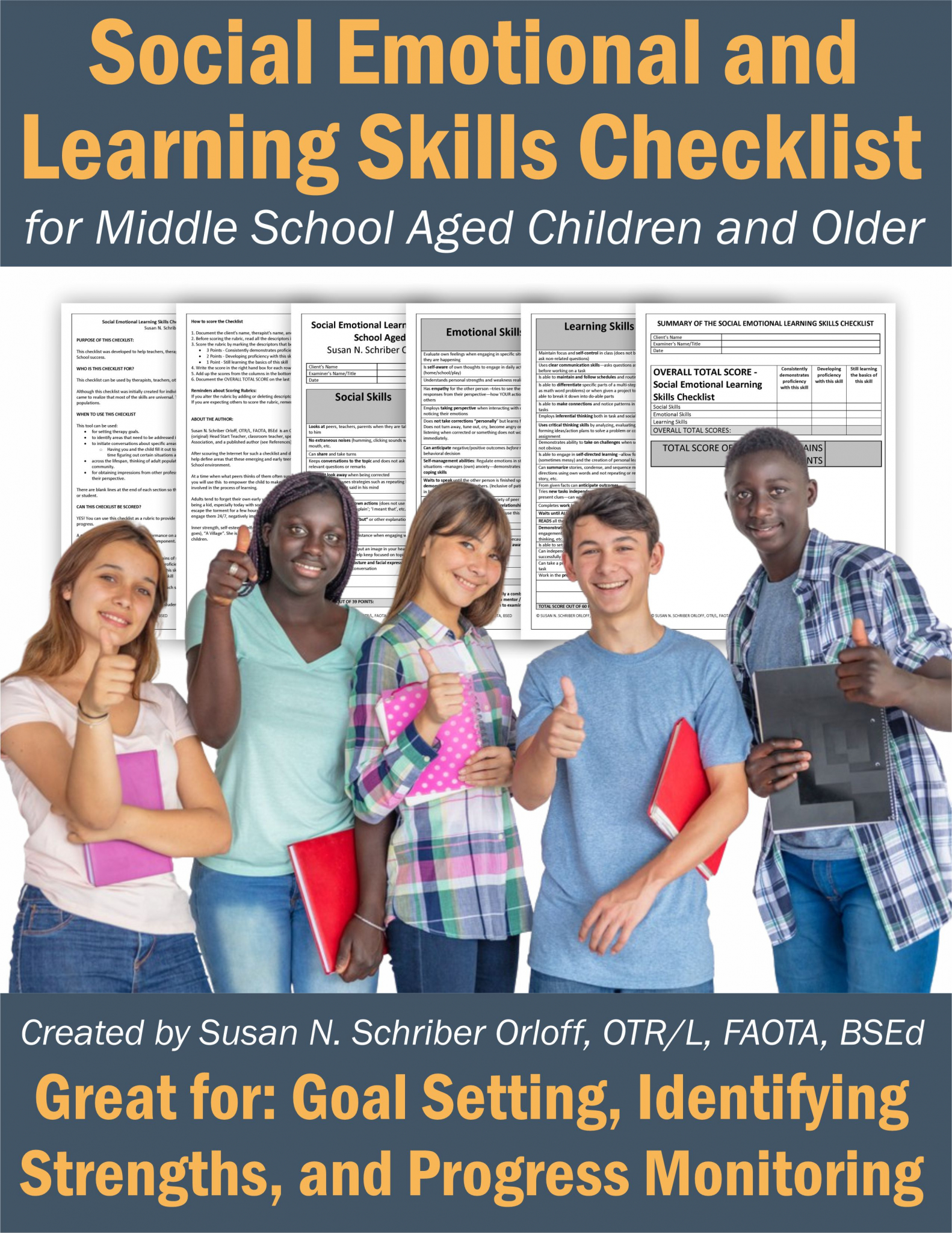
Social Emotional Skills Checklist
WHAT ARE EXAMPLES OF ON TASK BEHAVIOR?
There are many behavior checklists for students that you can use to help make sure your child is on task behavior. Here are some common on task behavior examples:
– Following instructions the first time they are given
– Staying seated unless told otherwise
– Keeping their hands and feet to themselves
– Raising their hand to speak or ask a question
– Recording homework assignments
– Being prepared with materials such as pencils, pens, and erasers to assist with staying on task
– Responding to questions when called upon
– Listening attentively without side conversations
– Remaining on task during work time
– Completing all assigned work
– Working quietly without disturbing others
These are just a few examples, but on task behavior will vary based on the specific situation and classroom rules.
HOW TO USE A BEHAVIOR CHECKLIST
There are many ways that you can use a behavior checklist for students. Here are some tips on how to get the most out of this tool:
– Use it as a form of data collection. Keep track of behavior over time to identify trends.
– Use it as a self-assessment tool. Have students use the checklist to track their own progress.
– Use it as a way to identify areas of improvement. Use the checklist to pinpoint areas where your child may need more support.
– Use it as a positive reinforcement tool. Celebrate progress and reward your child when they display positive behavior.
Behavior checklists are a valuable tool for teachers. By using them, you can create a more positive classroom environment and help your students be successful.
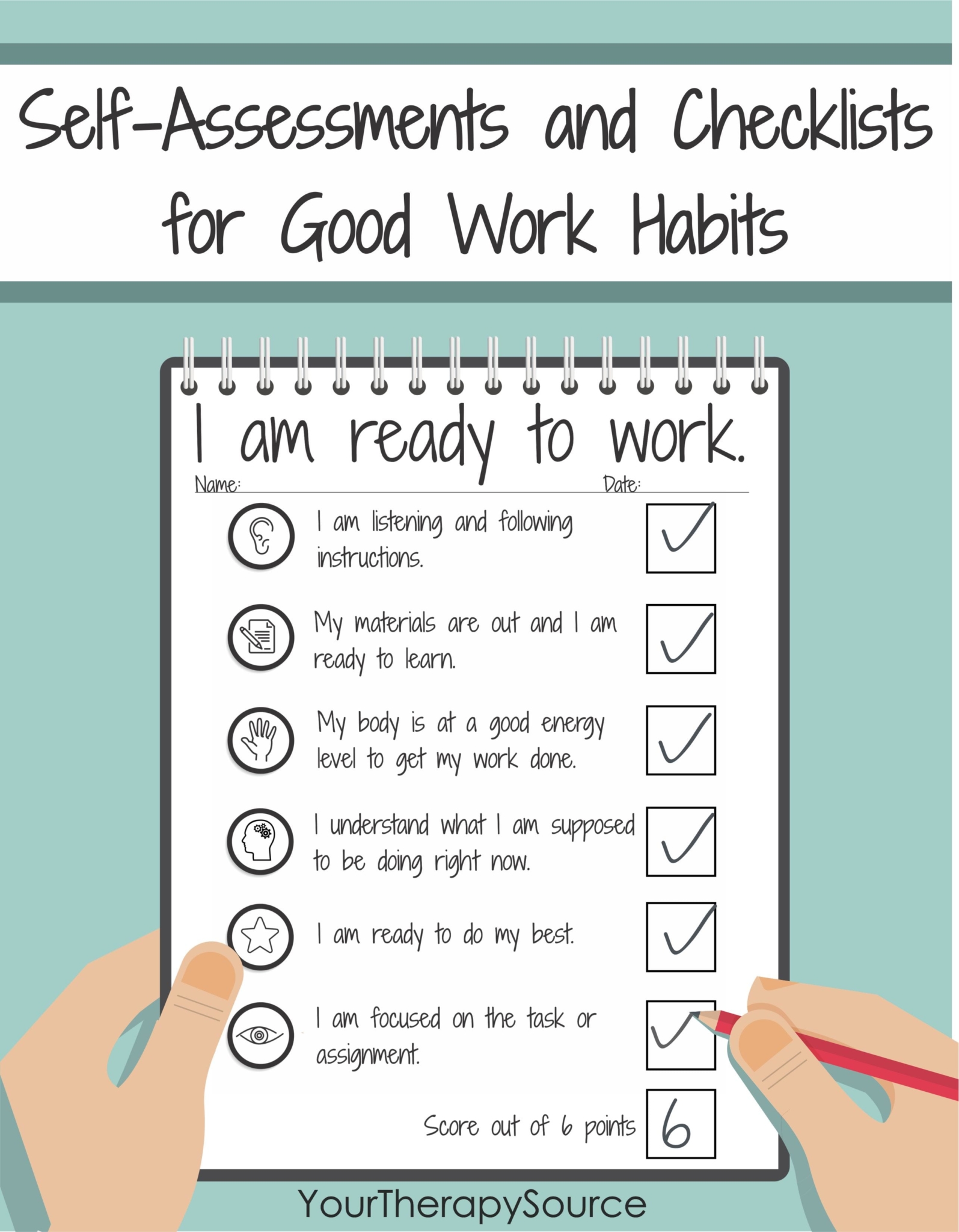
Self-Assessments and Checklists for Good Work Habits
BEHAVIOR CHECKLIST FOR SPECIAL EDUCATION STUDENTS
Every student has unique strengths and challenges, and some may benefit from structured tools to support their success in the classroom. Behavior checklists can be a helpful resource for certain students, but they are not the right fit for everyone. When used appropriately, they can provide insights into patterns and help educators and students recognize areas where additional support or skill-building may be beneficial.
For special education students, checklists should be individualized to reflect their specific needs and goals. Some students, such as those with ADHD, anxiety, or emotional regulation challenges, may find self-assessment checklists helpful for increasing independence and self-awareness. However, for other students, different strategies may be more effective. Educators and support teams should use professional judgment to determine whether a checklist is an appropriate tool for a particular student.
If daily self-assessment checklists are part of a student’s support plan, they may be included in their Individualized Education Program (IEP) to ensure consistency and alignment with their goals. Additionally, for students who require more in-depth behavioral support, a Functional Behavior Assessment (FBA) may be necessary to gather data and create a targeted intervention plan.
The key is to approach these tools with flexibility, sensitivity, and a focus on student growth, ensuring that they serve as a supportive resource rather than a rigid expectation.
WHAT SKILLS ARE INCLUDED ON THE FREE BEHAVIOR CHECKLIST FOR STUDENTS?
The free behavior checklist for students includes 15 skills. These are written in self-assessment format so the student can be independent with the task. There is also a blank page included for you to collaborate with the student to determine goals that are specific to each individual student.
The SCHOOL CHECKLIST is provided in two forms:
- Observation Form or Teacher Behavior Checklist – The teacher or adult can check off the skills that the student is able to accomplish for baseline data and progress monitoring.
- Self-Assessment Form – Students can use this checklist to self-monitor throughout the school day and track progress towards their goals.
BEHAVIOR CHECKLIST FOR STUDENTS – OBSERVATION VERSION
- Remains in seat during important lessons.
- Stays on task and works on the assigned activity.
- Avoid distractions in the classroom.
- Does not talk to other students during lessons.
- Pays attention to the teacher’s presentation.
- Takes notes during lessons.
- Works independently during class.
- Does not touch other students.
- Does not argue with the teacher over inappropriate behavior.
- Student is kind and does not verbally attack students or the teacher.
- Does not interrupt the lesson with inappropriate behaviors.
- Cooperates and follows the class routine.
- Keeps workspace organized and free of clutter.
- Participates in class discussions.
- Stays in class except for occasional trips to the bathroom or nurse.

Sensory Behaviors Checklist
BEHAVIOR CHECKLIST FOR STUDENTS – SELF-ASSESSMENT VERSION
- I remain in my seat during important lessons.
- I am staying on task and working on the assigned activity.
- I avoid distractions in the classroom.
- I am not talking to other students during lessons.
- I am paying attention to the teacher’s presentation.
- I take notes during lessons.
- I am working independently during class.
- I am not touching other students.
- I am not arguing with the teacher over my behavior.
- I am kind. I am not verbally attacking students or the teacher.
- I am not interrupting the lesson with inappropriate behaviors.
- I am cooperating and following the class routine.
- I keep my workspace organized and free of clutter.
- I participate in class discussions.
- I stay in class except for occasional trips to the bathroom or nurse.
BENEFITS OF USING A BEHAVIOR CHECKLIST FOR STUDENTS
A behavior checklist for students can help to improve behavior in the classroom. Some examples of the benefits of using a behavior checklist for students are:
- provide a list of expectations for behavior to clarify what is expected of students. This can reduce disruptive behavior, as students are more likely to be aware of the consequences of their actions.
- identify problem areas, such as aggressive behavior or if a student is consistently disruptive during certain activities. This allows teachers to target specific areas for improvement.
- offers a visual reminder of desired behaviors. When used effectively, a behavior checklist can be a valuable tool for promoting positive behavior in the classroom such as following routines and punctuality.
- helping with goal acquisition. Checklists help everyone stay focused on the overall goal and targeted behavior.
- provides a baseline to determine a behavior intervention that will be helpful to reduce the child’s behaviors that are negative.
- encourages independence. Using a behavior checklist for students as a self-assessment tool can reinforce positive student behavior without adult assistance.
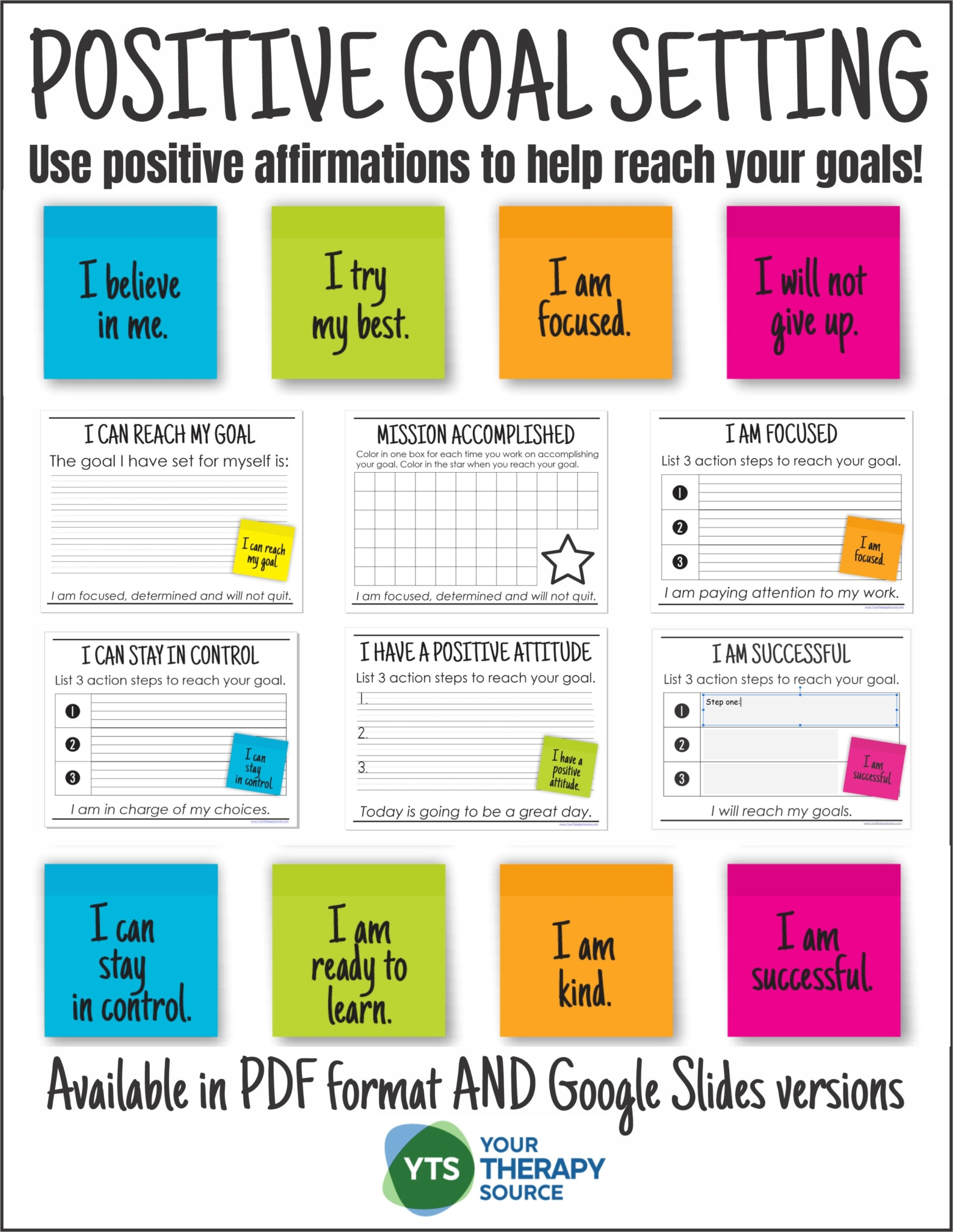
Positive Goal Setting
ACCESS YOUR STUDENT BEHAVIOR CHECKLIST PDF HERE
Sign up to receive the email newsletters and announcements from Your Therapy Source. If you are already signed up simply enter your email to access the download. You will not be subscribed twice. If you do not see the sign up box, click on the small blue box in the corner or email us at info@yourtherapysource.com and reference this freebie.
